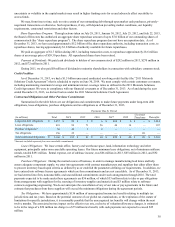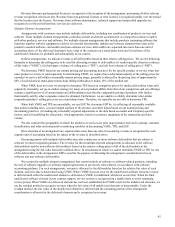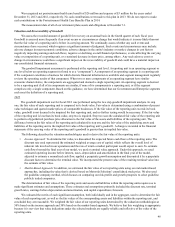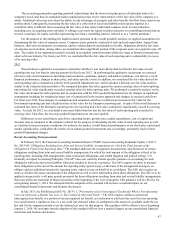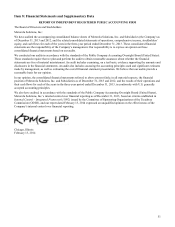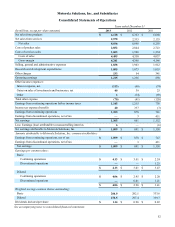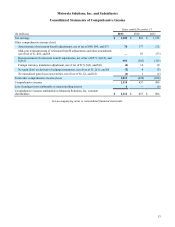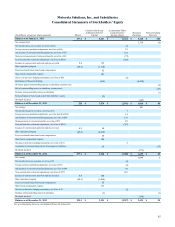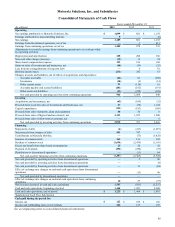Motorola 2013 Annual Report Download - page 48
Download and view the complete annual report
Please find page 48 of the 2013 Motorola annual report below. You can navigate through the pages in the report by either clicking on the pages listed below, or by using the keyword search tool below to find specific information within the annual report.
46
We recognized net postretirement health care benefit of $26 million and expense of $3 million for the years ended
December 31, 2013 and 2012, respectively. No cash contributions were made to this plan in 2013. We do not expect to make
cash contributions to the Postretirement Health Care Benefits Plan in 2014.
The measurement date of all of our retirement plans assets and obligations is December 31.
Valuation and Recoverability of Goodwill
We assess the recorded amount of goodwill for recovery on an annual basis in the fourth quarter of each fiscal year.
Goodwill is assessed more frequently if an event occurs or circumstances change that would indicate it is more-likely-than-not
that the fair value of a reporting unit is below its carrying amount. We continually assess whether any such events and
circumstances have occurred, which requires a significant amount of judgment. Such events and circumstances may include:
adverse changes in macroeconomic conditions, adverse changes in the entity's industry or market, changes in cost factors
negatively impacting earnings and cash flows, negative or declining overall financial performance, events affecting the carrying
value or composition of a reporting unit, or a sustained decrease in share price, among others. Any such adverse event or
change in circumstances could have a significant impact on the recoverability of goodwill and could have a material impact on
our consolidated financial statements.
The goodwill impairment assessment is performed at the reporting unit level. A reporting unit is an operating segment or
one level below an operating segment (referred to as a “component”). A component of an operating segment is a reporting unit
if the component constitutes a business for which discrete financial information is available and segment management regularly
reviews the operating results of that component. When two or more components of an operating segment have similar
economic characteristics, the components are aggregated and deemed a single reporting unit. An operating segment is deemed
to be a reporting unit if all of its components are similar, if none of its components is a reporting unit, or if the segment
comprises only a single component. Based on this guidance, we have determined that our Government and Enterprise segments
each meet the definition of a reporting unit.
2013
The goodwill impairment test for fiscal 2013 was performed using the two step goodwill impairment analysis. In step
one, the fair value of each reporting unit is compared to its book value. Fair value is determined using a combination of present
value techniques and quoted market prices of comparable businesses. If the fair value of the reporting unit exceeds its book
value, goodwill is not deemed to be impaired for that reporting unit, and no further testing would be necessary. If the fair value
of the reporting unit is less than its book value, step two is required. Step two uses the calculated fair value of the reporting unit
to perform a hypothetical purchase price allocation to the fair value of the assets and liabilities of the reporting unit. The
difference between the fair value of the reporting unit calculated in step one and the fair value of the underlying assets and
liabilities of the reporting unit is the implied fair value of the reporting unit's goodwill. A charge is recorded in the financial
statements if the carrying value of the reporting unit's goodwill is greater than its implied fair value.
The following describes the valuation methodologies used to derive the fair value of the reporting units:
• Income Approach: To determine fair value, we discounted the expected future cash flows of the reporting units. The
discount rate used represented the estimated weighted average cost of capital, which reflects the overall level of
inherent risk involved in our operations and the rate of return a market participant would expect to earn. To estimate
cash flows beyond the final year of our model, we used a terminal value approach. Under this approach, we used
estimated operating income before interest, taxes, depreciation and amortization in the final year of the model,
adjusted to estimate a normalized cash flow, applied a perpetuity growth assumption and discounted it by a perpetuity
discount factor to determine the terminal value. We incorporated the present value of the resulting terminal value into
the estimate of fair value.
• Market-Based Approach: In addition, we estimated the fair value of our reporting units using several market-based
approaches, including the value that is derived based on Motorola Solutions' consolidated stock price. We also used
the guideline company method, which focuses on comparing our risk profile and growth prospects to select guideline
publicly traded companies.
The determination of fair value of the reporting units and assets and liabilities within the reporting units requires us to
make significant estimates and assumptions. These estimates and assumptions primarily included the discount rate, terminal
growth rates, earnings before depreciation and amortization, and capital expenditures forecasts.
We evaluated the merits of each significant assumption, both individually and in the aggregate, used to determine the fair
value of each reporting unit, as well as the fair values of the corresponding assets and liabilities within the reporting unit, and
concluded they are reasonable. We weighted the fair value of our reporting units determined by the valuation methodologies at
50% based on the income approach and 50% based on the market-based approach. We believe that this weighting is appropriate
because it is our view that value indications under the selected methods are equally reliable and reflective of the value of the
reporting units.




